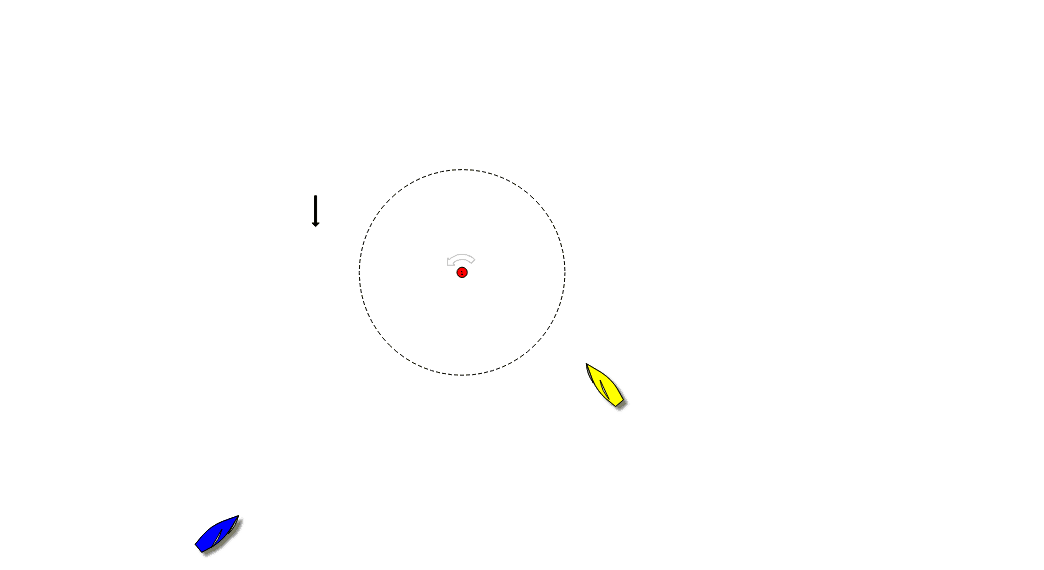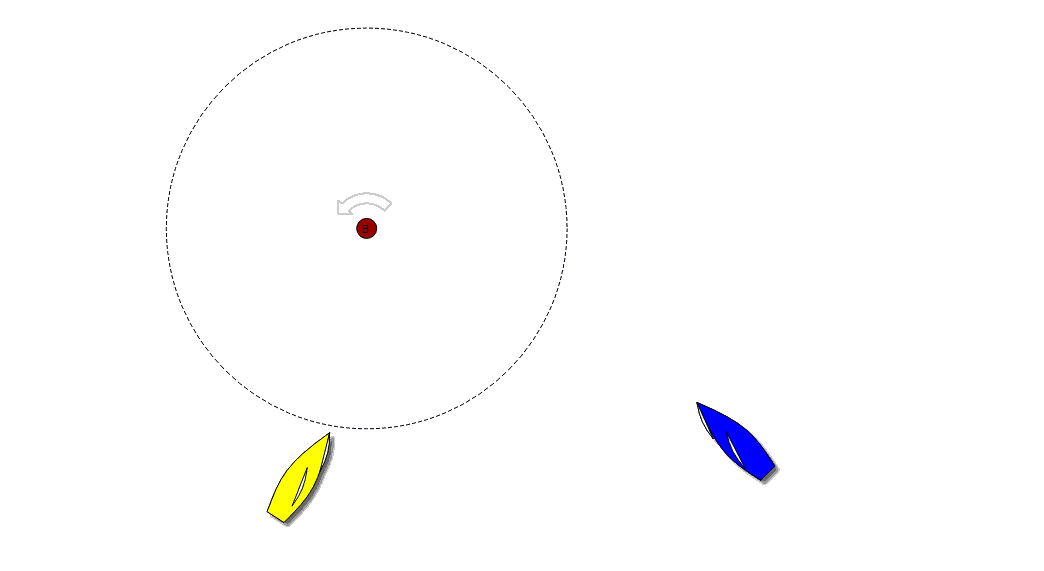
Rules


Rule 18, titled “Mark-Room,” is obviously the most important rule when you’re near a mark. However, it doesn’t apply in every situation at every mark, and when it does apply, others rules also apply. Rule 18’s intent is to enable two or more boats that are close to one another to round or pass a mark without damage or injury in a fair, orderly, and predictable way that preserves the order of the boats that was established before they reached the mark. Before we can even begin to understand Rule 18, however, we must learn the following five basic principles:
1. Whenever two boats meet, a rule applies that requires one of the two boats to keep clear. The other boat is the right-of-way boat, and the rule, which is called a “right-of-way rule,” is almost always one of the four rules in Section A. One, and only one, of those four rules can apply at any moment in time between a pair of boats. There are exceptions to this principle, but they rarely occur (if you’re inclined, see Rules 19, 22, and 23).
2. Nine (9) rules in Part 2 define when one boat must give another boat room or mark-room to perform a specified maneuver. I call these “room rules.” Rule 18 is one of them.
3. When a boat that has right of way is simultaneously required to give room, both the right-of-way rule and the room rule apply. Also, when a boat that must keep clear of another boat is simultaneously required to give that other boat room, both the right-of-way rule and the room rule apply.
4. When two boats meet, particularly when contact occurs, it often happens that each boat breaks a rule. In such a case, one of the two may be exonerated. There are three rules that provide for exoneration: Rules 64.1(a), 21, and 14(b).
5. Whenever two or more boats meet, Part 2 rules apply pair-wise between them. If Peter, Paul, and Mary are involved in an incident, for example, the rules must be applied separately to Peter and Paul, Peter and Mary, and Paul and Mary. The rules that apply to one pair often do not apply to another. For example, if Mary is on starboard tack, and Peter and Paul are on port and overlapped, Rule 10 applies between Mary and Peter, and between Mary and Paul, but Rule 11 applies between Peter and Paul.
Rule 18 is by far the longest and wordiest of all Part 2 rules. Its main purpose is to state when one of a pair of boats must give mark-room to the other. Mark-Room must be given only when one of three sub-parts of Rule 18 applies—Rule 18.2(a), Rule 18.2(b), or Rule 18.3(b). Before we examine how each of these three rules works, it’s logical to explore when Rule 18 applies.
Rule 18 is in Section C of Part 2. Rule 18.1’s first sentence contains a condition that must be met before any part of Rule 18 applies between a pair of boats. The boats must both be required to leave the mark that they are near on the same side, and one of them must be in the three-length zone around the mark. There are, however, circumstances under which Rule 18 does not apply, even if the condition in Rule 18.1’s first sentence is met (see Rules 18.1(a), (b), (c), (d), and the preamble to Section C). Here’s a simplified list of those circumstances. Rule 18 does not apply if:
The pair of boats is approaching a starting mark surrounded by navigable water on their final approach to start.
The boats are on opposite tacks on a beat to windward.
The boats meet while one of them is approaching the mark and the other has already rounded it and is leaving it (see images).


Rule 18 does not apply because Blue is approaching the mark and Yellow is leaving it. Yellow must keep clear of Blue under Rule 11. Rule 15 does not protect Yellow because it was Yellow’s action (jibing) that gave Blue right of way.
Rule 18 does not apply because Blue is approaching the mark and Yellow is leaving it. Yellow acquired right of way under Rule 10 when he tacked around the mark onto starboard. Yellow is required by Rule 15 to initially give Blue room to keep clear.
The mark is so large that it is a “continuing obstruction.” That term is not defined in the rules, but the only times I have seen it apply are when you are required to round an island to sail the course. In that case, Rule 19 applies while you round and not Rule 18
So what’s left? Rule 18 does apply: at all leeward marks, including the marks of a gate at the end of a leeward leg, at the marks at the end of reaching legs, and at all finishing marks; also at a windward mark, but only if the two boats in the pair are on the same tack.
Now, finally, let’s begin to discuss situations in which one boat in a pair is required to give the other boat mark-room. Rule 18.2(b) covers about 90 percent of these situations. We’ll discuss two simple Rule 18.2(b) situations . I’ll cover more examples involving Rule 18.2(b) and also discuss situations in which mark-room must be given under either Rule 18.2(a) or Rule 18.3(b).
In the examples in Image 1 and 2, two boats are overlapped at the moment when the first of them reaches the zone. The mark is a leeward mark that the boats are required to leave to port, and the next leg is a beat to windward. In these two examples, the inside overlapped boat begins to be entitled by Rules 18.2(b) and (c) to mark-room at the time she reaches the zone. Rule 18.2(c)(1) tells her that she will continue to be entitled to mark-room even if the overlap is broken or a new overlap begins. The inside boat’s right to mark-room will end when she has been given mark-room and had time to take it, or if she passes head to wind or leaves the zone, whichever of those three events occurs first. While Rule 18.2(b) applies, at least three other rules also apply. One is the basic right-of-way rule applicable between the two boats. The others are Rule 21 and Rule 14. In some Rule 18.2(b) situations, one or more of Rules 16.1, 17, and 18.4 also apply.
Blue is required by Rule 18.2(b) to give Yellow mark-room. Yellow is required by Rule 11 to keep clear of Blue. As a result, Yellow is only entitled to make a seamanlike approach and rounding of the mark.

IMAGE 1
Yellow is required by Rule 18.2(b) to give Blue mark-room. Yellow is required by Rule 11 to keep clear of Blue. As a result, Blue is in the driver’s seat. She is entitled to make a tactical approach and rounding of the mark.

IMAGE 2
In the examples in Images 1 and 2, two boats are overlapped at the moment when the first of them reaches the zone. The mark is a leeward mark that the boats are required to leave to port, and the next leg is a beat to windward. In these two examples, the inside overlapped boat begins to be entitled by Rules 18.2(b) and (c) to mark-room at the time she reaches the zone. Rule 18.2(c)(1) tells her that she will continue to be entitled to mark-room even if the overlap is broken or a new overlap begins. The inside boat’s right to mark-room will end when she has been given mark-room and had time to take it, or if she passes head to wind or leaves the zone, whichever of those three events occurs first. While Rule 18.2(b) applies, at least three other rules also apply. One is the basic right-of-way rule applicable between the two boats. The others are Rule 21 and Rule 14. In some Rule 18.2(b) situations, one or more of Rules 16.1, 17, and 18.4 also apply.
In the situation in Image 1, Blue and Yellow are both on port tack with Blue having right of way under Rule 11. Yellow, the inside boat, is entitled to mark-room. That is room to carry out two maneuvers—room to sail to the mark and room to round the mark as necessary to sail the course. Room for Yellow to sail to the mark is space to sail in an approximately straight line from where she enters the zone to a position in which the mark is on her port side and close alongside her. Room for Yellow to round the mark as necessary to sail the course is space to round up from her downwind course to a close-hauled port-tack course.
The definition Room implies that Yellow is entitled to the space she needs in the existing conditions to make these two maneuvers promptly in a seamanlike way—i.e., she is entitled to space to make a seamanlike, but not a tactical approach to and rounding of the mark. If she sails within that space, she will be exonerated under Rule 21 if she breaks Rule 11, or if she is compelled to touch the mark. Also, Yellow may round up to a close-hauled port-tack course as rapidly as she pleases, provided she does so in a seamanlike way, and Blue must anticipate her right to do so. Blue must give Yellow the mark-room to which she is entitled, and if he fails to do so, he breaks Rule 18.2(b).
In Image 2, both boats are on starboard tack with Blue, as the leeward boat, holding right of way under Rule 11 and, as the inside boat, entitled to mark-room under Rule 18.2(b). Because Blue has the right of way, she has better options than Yellow had in the Image 1 situation. While she has right of way, Blue may use her right of way to sail farther from the mark than Yellow was permitted to sail in the Image 1 situation.
Having right of way entitles Blue to set up for a wide-then-close tactical approach and rounding. However, if she does so, she must comply with Rule 16.1 if she changes her course, with Rule 17 if it applies between her and Yellow, and with Rule 18.4 by not sailing farther from the mark before jibing than she would have sailed if Yellow were not present. Also, if Blue does choose to make the tactical approach to the mark, she will not be “sailing within the mark-room to which she is entitled.” Therefore, she will not be exonerated under Rule 21 if she breaks Rule 16.1. When Blue jibes, Yellow becomes the right-of-way boat, so Blue will lose her right to make a tactical rounding, and the rules that will apply to her will be those that applied to Yellow in Image 1. However, after Blue jibes, if she sails within the space that mark-room entitles her to, she will enjoy the protection that Rule 21 provides.
This discussion of Rule 18.2(b) enables us to answer a question that’s frequently asked: “When can I make a tactical approach and rounding of a mark, and when am I limited to just a seamanlike approach and rounding?” The answer is: “If you are entitled to mark-room and have right of way, you may position your boat for a tactical approach and rounding. If you are entitled to mark-room but do not have right of way, then you are only entitled to space for a seamanlike approach and rounding.”
Some Situations

When Blue becames overlapped with Yellow, Rule 18 no longer applies. Blue has right-of-way as starboard-tack boat, and Yellow must keep clear.

Blue owes Yellow mark-room, and if Blue cuts between Yellow and the mark, Blue does so at his own risk.
ISAF RRS 18.3 : Tacking in the zone

If a boat in the zone passes head to wind and is then on the same tack as a boat that is fetching the mark, Rule 18.2 does not thereafter apply between them. The boat that changed tack (a) shall not cause the other boat to sail above close-hauled to avoid contact or prevent the other boat from passing the mark on the required side, and (b) shall give mark-room if the other boat becomes overlapped inside her.
Case 133: Rule 18.3, Tacking in the Zone
Rule 18.3 is intended to help a big fleet round the windward mark in an orderly way when boats are required to leave the mark to port. It rewards boats that approach the zone on starboard tack. It does not automatically penalize a boat that enters the zone on port tack and then tacks to starboard, but it makes such an approach to the windward mark risky when other boats are nearby. Cases 93 and 95 show how Rule 18.3 applies to incidents involving two boats. New Case 133 is the first case to cover a three-boat incident.
This case sends a strong warning to port-tack boats not to tack in the vicinity of a starboard-tack boat fetching the windward mark. There was space for one boat to pass between (N) and the mark without causing (N) to sail above closehauled, but when both (A) and (M) tried to fit into that space, both of them were disqualified.






